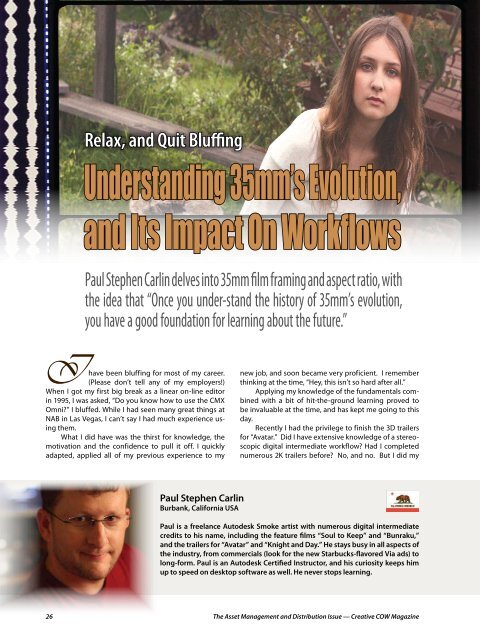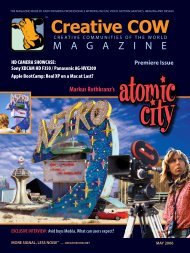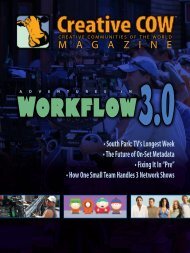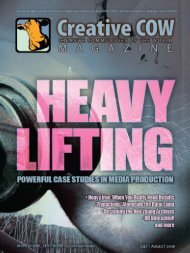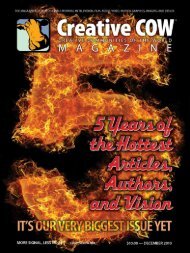Read the COW Magazine Online - Creative COW Magazine
Read the COW Magazine Online - Creative COW Magazine
Read the COW Magazine Online - Creative COW Magazine
Create successful ePaper yourself
Turn your PDF publications into a flip-book with our unique Google optimized e-Paper software.
Relax, and Quit Bluffing<br />
Understanding 35mm’s Evolution,<br />
and Its Impact On Workflows<br />
Paul Stephen Carlin delves into 35mm film framing and aspect ratio, with<br />
<strong>the</strong> idea that “Once you under-stand <strong>the</strong> history of 35mm’s evolution,<br />
you have a good foundation for learning about <strong>the</strong> future.”<br />
I have been bluffing for most of my career.<br />
(Please don’t tell any of my employers!)<br />
When I got my first big break as a linear on-line editor<br />
in 1995, I was asked, “Do you know how to use <strong>the</strong> CMX<br />
Omni?” I bluffed. While I had seen many great things at<br />
NAB in Las Vegas, I can’t say I had much experience using<br />
<strong>the</strong>m.<br />
What I did have was <strong>the</strong> thirst for knowledge, <strong>the</strong><br />
motivation and <strong>the</strong> confidence to pull it off. I quickly<br />
adapted, applied all of my previous experience to my<br />
Paul Stephen Carlin<br />
Burbank, California USA<br />
new job, and soon became very proficient. I remember<br />
thinking at <strong>the</strong> time, “Hey, this isn’t so hard after all.”<br />
Applying my knowledge of <strong>the</strong> fundamentals combined<br />
with a bit of hit-<strong>the</strong>-ground learning proved to<br />
be invaluable at <strong>the</strong> time, and has kept me going to this<br />
day.<br />
Recently I had <strong>the</strong> privilege to finish <strong>the</strong> 3D trailers<br />
for “Avatar.” Did I have extensive knowledge of a stereoscopic<br />
digital intermediate workflow? Had I completed<br />
numerous 2K trailers before? No, and no. But I did my<br />
Paul is a freelance Autodesk Smoke artist with numerous digital intermediate<br />
credits to his name, including <strong>the</strong> feature films “Soul to Keep” and “Bunraku,”<br />
and <strong>the</strong> trailers for “Avatar” and “Knight and Day.” He stays busy in all aspects of<br />
<strong>the</strong> industry, from commercials (look for <strong>the</strong> new Starbucks-flavored Via ads) to<br />
long-form. Paul is an Autodesk Certified Instructor, and his curiosity keeps him<br />
up to speed on desktop software as well. He never stops learning.<br />
26 The Asset Management and Distribution Issue — <strong>Creative</strong> <strong>COW</strong> <strong>Magazine</strong><br />
homework and hit <strong>the</strong> ground running —<br />
and never looked back.<br />
The key to success is to never stop learning.<br />
Life is about growing and learning — only<br />
to realize you know nothing at all. Many of us<br />
tend to focus on one particular aspect of <strong>the</strong><br />
industry. We become specialists in what we<br />
know. I have found that having knowledge<br />
of <strong>the</strong> inner workings of o<strong>the</strong>r parts of <strong>the</strong><br />
industry proves to be invaluable, no matter<br />
what I’m working on.<br />
In this article, I want to cover <strong>the</strong> basics<br />
of 35mm film framing and aspect ratios, and<br />
some of <strong>the</strong> differences between <strong>the</strong> acquisition<br />
and distribution film formats.<br />
Why should you learn about 35mm film,<br />
when it is clearly on its way to oblivion? Because<br />
everything we use today is based on<br />
something we did yesterday. Once you understand<br />
<strong>the</strong> history of 35mm’s evolution,<br />
you have a good foundation for learning<br />
about <strong>the</strong> future.<br />
35MM FILM<br />
Ever since George Eastman mass-produced<br />
<strong>the</strong> first flexible transparent motion picture<br />
film stock in 1889, and Thomas Edison standardized<br />
<strong>the</strong> 35mm format in 1892, not much<br />
has changed in <strong>the</strong> world of film stock. There<br />
were o<strong>the</strong>rs with ideas about frame sizes and<br />
aspect ratios, but <strong>the</strong> first round of format<br />
wars for motion picture film ended in 1909<br />
with <strong>the</strong> standardization of a 35mm gauge<br />
(width), with 4 perforations per frame along<br />
both edges and a 1.33:1 aspect ratio.<br />
A 1.33:1 (spoken as “one point three three<br />
to one,” or simply “one three three”) aspect<br />
ratio means that one side of <strong>the</strong> image is 1.33<br />
times longer than <strong>the</strong> o<strong>the</strong>r. This same screen<br />
aspect ratio was later adopted by television,<br />
known <strong>the</strong>re as 4:3 (four by three).<br />
So how did we go from this to where we<br />
are today, with our 16:9 televisions and widescreen<br />
movies?<br />
FRAME SIZES AND ASPECT RATIOS<br />
In <strong>the</strong> original Edison standard, <strong>the</strong> film was<br />
35mm wide from edge to edge, with an image<br />
area of 24.89 mm by 18.67 mm, surrounded<br />
by four sprockets on each side. This is called<br />
full aperture, or what was later referred to as<br />
silent gate — <strong>the</strong> width of <strong>the</strong> frame in silent<br />
movies.<br />
When sound was introduced, room had<br />
to be made for <strong>the</strong> optical audio tracks. The<br />
Academy of Motion Picture Arts and Sciences<br />
decided to reduce and move <strong>the</strong> image area<br />
to <strong>the</strong> right. The resultant aspect ratio became<br />
1.37:1, and is called <strong>the</strong> Academy ratio.<br />
After <strong>the</strong> phenomenal success of Cin-<br />
Above: Panavision was started in 1953, by Robert Gottschalk, to<br />
build anamorphic lenses for <strong>the</strong> motion picture industry. This is <strong>the</strong><br />
company’s latest G Series prime lenses. Note <strong>the</strong> unique cylindrical<br />
glass element on <strong>the</strong> front of <strong>the</strong> lens. The anamorphic element can<br />
also be located in <strong>the</strong> middle or rear of <strong>the</strong> lens.<br />
Below: A comparison of <strong>the</strong> anamorphic scope image area vs. super<br />
35 center cut. The anamorphic lens squeezes a 2.39:1 image into<br />
<strong>the</strong> Academy frame, while <strong>the</strong> super 35 center cut image is simply a<br />
2.39:1 image in <strong>the</strong> middle of <strong>the</strong> full aperture frame. Anamorphic<br />
uses <strong>the</strong> entire vertical height, while Super 35 uses <strong>the</strong> area normally<br />
reserved for optical audio to improve <strong>the</strong> size of <strong>the</strong> image area.<br />
<strong>Read</strong> on for an explanation of all <strong>the</strong>se terms!<br />
erama in 1952, which involved three separate 35mm projectors to<br />
create a 2.59:1 aspect ratio, studios began looking into o<strong>the</strong>r, possibly<br />
more economical, ways to capitalize on widescreen images,<br />
and differentiate <strong>the</strong>mselves from <strong>the</strong> ever-encroaching television<br />
screens.<br />
(Studios also experimented with 3D, but we all know that<br />
turned out to be nothing but a fad!)<br />
In 1953, 20th Century Fox introduced CinemaScope, an anamorphic<br />
widescreen format with a 2.66 aspect ratio. This was<br />
achieved by placing an anamorphic lens in front of both <strong>the</strong> camera<br />
and <strong>the</strong> projector to horizontally squeeze and correspondingly<br />
un-squeeze <strong>the</strong> image at a ratio of 2:1.<br />
This means that <strong>the</strong> full aperture image of 1.33 was multiplied<br />
<strong>Creative</strong> <strong>COW</strong> <strong>Magazine</strong> — The Asset Management and Distribution Issue 27


